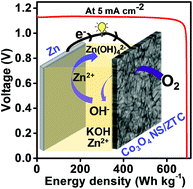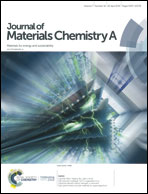Co3O4 nanosheets on zeolite-templated carbon as an efficient oxygen electrocatalyst for a zinc–air battery†
Abstract
Zinc–air batteries (ZnABs) are among the most promising energy storage devices, offering multiple advantages of high energy density, low manufacturing cost, high safety, and environmental benignity. However, challenges remain in the development of ZnAB electrode materials due to the lack of efficient air-electrode catalysts for solving the problems regarding slow kinetics of the oxygen reduction/evolution reactions (ORR/OER) and poor durability. Here, we report the formation of Co3O4 nanosheets with rich oxygen-vacancy defects grown on zeolite-templated carbon (ZTC) for electrocatalytic application in a ZnAB. Hydrophobic ZTC serves as a substrate for the growth of the Co3O4 nanosheets. Oxygen vacancies are generated by the borohydride reduction of Co2+, followed by oxidation with oxygen in atmospheric air. The resultant oxygen-vacancy defective Co3O4 nanosheets on ZTC (Co3O4 NS/ZTC) exhibits excellent bifunctional electrocatalytic activity towards the ORR/OER and high durability, compared with commercial Pt/C and RuO2 catalysts. The high bifunctional electrocatalytic activity is attributed to the sheet-like structure and oxygen-vacancy defects of Co3O4 and the high surface area and uniform microporosity of ZTC. The ZnAB with the bifunctional electrocatalyst exhibits excellent discharge performance and long-term charge/discharge cycling stability.



 Please wait while we load your content...
Please wait while we load your content...